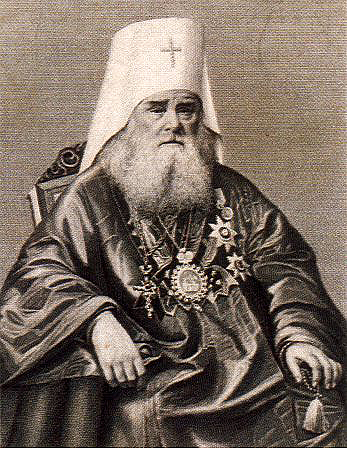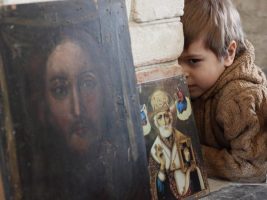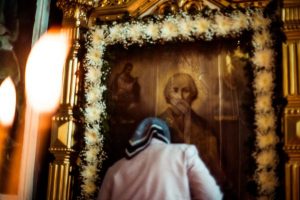 The Apostles, sent by the Savior of the world “to the ends of the earth,” did not reach its end. Their successors, the missionaries of the following centuries, picked up the baton. At the beginning of the nineteenth century the words of Christ reached the heart of John Veniaminov, a young priest in Irkutsk and the son of a simple sexton, and he accepted the call to his heart. This call led him to the very edge of the earth.
The Apostles, sent by the Savior of the world “to the ends of the earth,” did not reach its end. Their successors, the missionaries of the following centuries, picked up the baton. At the beginning of the nineteenth century the words of Christ reached the heart of John Veniaminov, a young priest in Irkutsk and the son of a simple sexton, and he accepted the call to his heart. This call led him to the very edge of the earth.
The missionary field of St. Innocent of the Aleutians (1797 – 1879; during the last years of his life he became the Metropolitan of Moscow) was the uttermost northeast of Eurasia and the extreme northwest of the North American continent. Today on this territory are many dioceses of two local Orthodox Churches, both Russian and American.
At the time these lands were the ends of the earth not only geographically. Father John, the future St. Innocent, met with so-called “traditional cultures.” Although some tribes (such as the Yakuts and Buryats) already had a rudimentary statehood, for the most part social differentiation was expressed very poorly even among tribes within the borders of the Russian Empire. This was a remarkable and complex situation. The Russian Orthodox missionary, who had behind him centuries of a Christian culture that had perfected combining Christianity with all spheres of human activity, was suddenly confronted with what Gauguin called the youth of humanity, with a primitively communal, traditional society.
Tribute should be paid to the reasonable softness of the Russian Empire’s national policy. For all of its devotion to the Byzantine model of church-state relations (as clearly reflected in the ideology of Uvarov in the nineteenth century), the Russian government – unlike the Spanish, Portuguese, French, Dutch, or English governments – did not lead a colonization policy in the classical (European) sense. Though they accepted the Orthodox Tsar, the inner life of the nations and people of the north were in no way bothered. (This would not be the same in the twentieth century…)
St. Innocent’s objective was to bring Truth in its simplicity, without traditional statehood and Eastern Orthodox culture, to the people “sitting in darkness and the shadow of death.” The apostolic missionary needs simplicity. The missionary that has it is, according to the Apostle Paul, “for all to all.” He brings people Christ, not a model of social relations; Christ, and not cultural values. When offered simply Christ, Christ alone, an inevitable choice is placed before the aborigine: to continue his pagan life or to seek and accept salvation. This choice is not as acute when a pagan meets a missionary and is shown not evangelical simplicity in all things, but rather the complex and confusing rites of the entire ecclesiastical-ethnic complex, which has accumulated over centuries.
In this regard, St. Innocent’s activity is one of the few exceptions to the general background of the Orthodox mission of the seventeenth to the nineteenth centuries. One can mention only two other names: St. Macarius (Gluharev) and St. Nicholas (Kasatkin), the Equal to the Apostles. St. Innocent’s greatness was that he was able to rise above himself, his nationality, his own culture, and the politics of his state. He drew away from it all. Remaining, of course, a true son of his people, he did not want to make Slavs out of the Indians and Aleuts. He made them Christians. He loved these people. Each tribe that he visited was interesting to him. Innocent studied its language, culture, life, and traditions. Why? So that he could facilitate the people’s conversion to Christianity by offering to absorb the latter in the context of their native culture. Today this is called enculturation. Here language played the main role.
Missionaries who worked among the Aleuts, Kamchadals, and Yakuts before St. Innocent did not know and did not seek to learn the languages of these tribes. The locals could hardly learn Russian, and certainly could not even comprehend Slavonic. Consequently, Christianity gradually diminished and the locals returned to their paganism in the second generation, or sometimes even in the first. They were ready to perform any external action and ritual obediently, but they did this quite unconsciously, sometimes not having the slightest idea about the basic truths of Christianity.
It is amazing how much work St. Innocent accomplished in Biblical and liturgical translations to foreign languages. He could perfectly and quickly master the languages of people from completely different language families: Turkic Yakuts, Paleo-Aleuts, Indians Koloshi. And this is not all! He learned the language, translated the Gospel, translated the Liturgy – and immediately began to serve in the language of the people to whom he preached. This happened especially fast with the Yakuts as a result of his previous great experience. His did not focus on aesthetic subtleties; his heart burned with the desire to help a gentile see the light of salvation.
St. Innocent’s contemporary, the economist Tikhmenev, commented on the translation aspect of the former’s missionary activity in a book devoted to the Russian-American campaign: in his “thorough study of their [the Aleuts of the Unalaska Island] native language, he differed sharply from other clergy that preached in that region. Translation of… the Catechism, Sacred Stories, St. Matthew’s Gospel, parts of St. Luke and the Acts of the Apostles, and compiling in the same language sermons on the duties of a Christian… pushed residents of Unalaska and its environs forward considerably in religious education in comparison with other natives” [P. Tikhmenev, Historical Review of Education in the Russian-American Campaign. St Petersburg., 1861. Part I, p. 228]. This is what the famous explorer F.P. Litke, traveling along the shores of Russian America in 1826-29, remarked upon: “The condition of the inhabitants of Unalaska, and in general (the islands)… has now changed in many ways. They are all Christians, but only from the time of Fr. John have they started to get some idea about the true meaning of this word” [“Missionary Review,” 1997, № 7. p. 8].
Firm belief in the need to give the Aleuts the word of God printed in their own language made Fr. John go on a round trip to St. Petersburg.
We can say about St. Innocent the same we can about the Apostle Paul: if he is not an apostle, then who is? Chukotka and Alaska know, and Kamchatka and the Kurils can say, who labored more than anyone in preaching the Gospel to them. That is why the Church called St. Innocent the Equal to the Apostles.
If you trace the tireless missionary’s paths on a map, their length will be much greater than even those of the Apostle Paul. It is amazing. No one can compare civilized Roman roads with the terrible roads of the taiga and tundra, with their harshness and solitude; it is difficult to compare the congenial Mediterranean with the intimidating Pacific Ocean. Some of the saint’s routes, for example, were up to 8,000 miles each. This much had to be travelled just to pass from one point to another of a diocese (from Blagoveshchensk to San Francisco.) This did not happen by means of airplanes or ships, but rather by dog sleds, reindeer sleds, or on foot. The saint used ropes to go down on the rocks of Kamchatka and sailed in a boat dugout along the Aleutian archipelago. During these voyages he had to sit tensely fifteen hours every day on waves in the chilly wind. It is simply impossible to portray the extreme hardships and sorrows of the brave missionary. We can only say that it was a colossal feat. This feat lasted fifty years, almost without interruption!
Today’s missionaries do not experience such difficulties in any place on the map. The most remote villages are quickly and easily accessible by helicopter or motorboat. In a seemingly deserted camp or village there are electricity, radio, and some tolerable level of comfort. Yet what if someone’s Christian soul yearns for missionary deeds? This endeavor now is the same as it was a hundred or a thousand years ago: to sacrifice one’s life for those to whom the Gospel is preached. This means that you have to become Ket for the Ket, Chinese for the Chinese, Papuan for the Papuans! This means to forget everything except Jesus, to have a willingness to sacrifice everything but Christ. To live among natives, to speak their language, to dress like them, to sit as they sit, to eat what they eat, and to learn to play their national instruments, and to use them to glorify God. Not the Byzantine eight-tone system, but the aborigine’s native tunes should form the music of their church services. Then the locals will not perceive the preaching of Orthodoxy as evangelization by an alien culture.
What prevents the progress of the foreign and domestic Orthodox mission? An objective reason for the underdevelopment of missionary service in our Eastern Orthodoxy is clergy familial ties. One should not despair: let us look to St. Innocent. Amazingly, he entered the missionary field as the father of many children: he had twelve! His family did not stop him, and later helped him carry out his missionary work, sharing all the sorrows and joys of this labor. Another reason is the inability of most missionaries to become encultured, to enter smoothly into the culture of other people. It is the inability and often unwillingness to renounce oneself and become Evenki for the Evenki, Tatar for the Tatars, Portuguese for the Portuguese, etc. Subsequently there are insurmountable barriers in communication.
We know the Gospel concludes with Christ’s call to missionary work. “Go and preach” – from the tents of the Selkups and Nganasans, to the Indian huts in the Amazon and Orinoco, to five-story buildings in Moscow and Abakan, to black huts in the Vologda and Kostroma regions, to the white houses of Andalusia and Alentezhu – “go and preach.” From the desert camps of reindeer herders in Taymyr and the gurgling cities of Europe, to the villages of hunters and to student audience – “Go and preach.” Pure, simple Orthodoxy. Just as St. Innocent preached.
Translated from Russian by Sophia Moshura
















